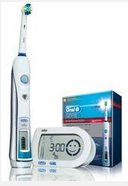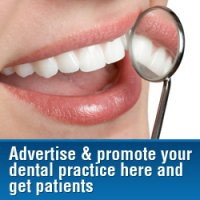
Electric Toothbrushes
An Electric Toothbrush is a toothbrush that uses electric power to move the brush head, based on oscillating/rotating, vibrating, or ultrasonic technology.
Modern electric toothbrushes are designed to help us keep our teeth and gums healthy and clean, using advanced technology brush head and bristle designs.
The electric toothbrush market includes the high-tech rechargeable models as well as the low cost battery-powered toothbrushes.
How to Choose the Best Electric Toothbrush for you
In order to choose the best electric toothbrush that provides you with adequate teeth cleaning, you should know that :
- Electric toothbrushes' handles have a variety shapes and materials; some are also quite bulky. Choose one that fits better and steadily to your grip.
- Most people feel more comfortable when brushing with a round and small brush head.
- Check the quality of the bristles. They should have rounded ends to avoid damaging the gums. The safest choice is a toothbrush with sodt bristles.
- Some toothbrushes have pressure sensors that regulate the speed of the brush to avoid damaging the teeth and gums. Prefer one of these, especially if you use to put too much pressure while brushing or your dentist has found enamel abrasions caused by brushing.
- If you suspect that you do not brush long enough, choose one of the toothbrushes with built-in timer, that help you to control the duration of brushing.
- Ask your dentist to advise you for the right toothbrush hardness (soft or medium) and type according to your specific needs, mouth shape and dental problems.
![]() Choosing the best electric toothbrush is not enough. Any toothbrush will be useless if you do not know how to brush your teeth.
Choosing the best electric toothbrush is not enough. Any toothbrush will be useless if you do not know how to brush your teeth.
Power Toothbrush vs. Manual Toothbrush
Even though there are some research data claiming that modern electric toothbrushes can clean better than the manual ones, other reasons such as facility and boosting of motivation are usually the main reasons to advise the use of an electric toothbrush. Most people do not brush their teeth correctly, due to improper brushing technique or not brushing long enough.
If you enjoy teeth brushing better with an electric toothbrush and brush with it more carefully, more often, or for the proper amount of time because of its easiness of use, then it can significantly improve oral hygiene.
Advantages of Electric Toothbrushes
- Only minimal skill level is needed to brush properly with an electric brush while a manual toothbrush requires manual dexterity and diligence. A good electric toothbrush will probably clean better in those cases where someone lacks the skills needed for manual brushing. For people who for various reasons have problems making the necessary movements of brushing (i.e. people with arthritis and elder people), electric brushes is the only solution.
- People tend to brush longer with a power toothbrush, as minimum effort is needed. If a person spends more time brushing with an electric toothbrush, it can lead to better removal of dental plaque .
- Many people and especially children prefer a power toothbrush due to the smaller brush head that is easier to reach all areas of their mouth, even to the back teeth without causing discomfort as some larger brush heads.
- Less brushing force is required by power toothbrushes to provide effective dental plaque removal than with manual toothbrushes. Normally, power toothbrushes are less likely to cause damage to tooth enamel and gums. Some of the best electric toothbrushes such as the Braun Oral-B or Sonicare range allow you to regulate the brushing time and pressure applied using a built in timer and pressure sensors.
- The novelty of a power toothbrush can be a strong motivation to encourage some people to give more importance to their daily dental hygiene (especially those who like gadgets and children
- An electric toothbrush is recommended for those who wear braces as it may reach crevices between braces and teeth that are not easily cleaned.
- In recent years even the premium power toothbrushes have become affordable and provide high quality performance.
Types of Power Toothbrushes
The electrical toothbrush designs are categorised by the type of the brush head’s shape and movement :
- The first generation of power toothbrushes had a head looking like the one of manual toothbrushes, and moving back and forth to simulate manual brushing. Only few low cost power toothbrushes use this -not efficient- mode today.
- Rotary toothbrushes. The next generation moved to a design with a circular head that is rotating in one direction.
- Counter-rotational toothbrushes with different tufts of bristles rotating in opposite directions
- Rotating-oscillating toothbrushes in which a circular head spins back and forth in quick bursts
- Oscillating-pulsating toothbrushes have in addition a pulsating motion to enhance the cleaning action
- The Sonic toothbrushes is the newest type of electric brushes. It has a conventionally shaped head which vibrates in very high speed (>30.000 strokes per minute). This vibrating motion is claimed to create turbulent fluid dynamics that disrupt and remove dental plaque even beyond the point where the tips of the toothbrush's bristles actually touch.
User tips • How to Brush Teeth with Electric Toothbrushes
The brushing technique for electric toothbrushes is quite different from that of a manual one. Electric toothbrushes perform most of the necessary movements on their own, so you do not have to apply as much pressure as you would with a manual toothbrush. The grip may vary from model to model due to different handle shapes.
- Put the head of the electric toothbrush on the buccal surface of each tooth at a 30 to 40 degree angle for about 2 seconds.
- Slowly move the brush from tooth to tooth.
- Repeat the action for the lingual (inner) surfaces of all teeth.
- Finally don’t forget to brush the chewing surfaces of all teeth.
- Normally toothbrushing should last for at least 2-3 minutes in order to provide effective teeth cleaning.
- Rinse and clean your brush head after each use.
- Replace your brush head every 3 months or sooner if the head is worn out. A worn out head may reduce your brush's effectiveness.
- Today there are many different kinds of power toothbrushes. Brushing with a sonic toothbrush requires a similar technique with that of manual toothbrushes. It is advised that you read the operating instructions supplied with your new electric toothbrush before first use, as different models may require different techniques.
Daily oral hygiene is essential for maintaining oral health. It should also be combined with proper healthy diet and regular dental visits.


